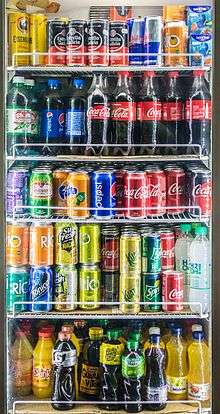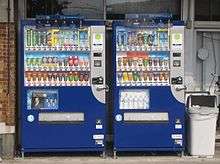Soft drinks
Different soft drinks are popular around the world. On a trip abroad you may encounter interesting beverages that you’ve never heard of before — do try them out.

Understand
| “ | A soft drink is a beverage that typically contains carbonated water, a sweetener and a natural or artificial flavoring. | ” |
—Wikipedia | ||
Sure, practically wherever you are in the world you can ask for a Coke and know what you’re gonna get. Though why not go for something else that you may not be able to get at home?
There are a couple of different kinds of soft drinks; common types include colas and fruit drinks (often orange or other citrus fruits). Also energy drinks may be regarded as soft drinks.
Carbonated soft drinks are also known as soda or pop in some parts of the world.
The volume served in restaurants varies considerably around the world, at one extreme, in the USA, sizes can vary from 0.3 liters to 1 liter (or even 2 liters in cinemas) and are refilled at no extra cost in some parts of the country, while at the other end in the Netherlands you will be served a 0.2l bottle which you will probably empty before your meal has arrived and will have to purchase a few more.
The very same beverage may also taste differently depending on the country it is produced in. For instance, soft drinks produced in the United States are usually sweetened with high fructose corn syrup which gives them a slightly different taste from the ones produced with regular sugar like in most of the rest of the world. In addition to this there are of course "diet", "light", "life" and other variants of the same product (explicitly marketed as a better version in one way or another) where aspartame, Acesulfame K or stevia has been used instead of sugar.
Branded drinks
Here are some soft drinks that can be regarded as local specialties in one way or another.
Africa
- Bonbon Anglais — a very sweet soda from Madagascar
Asia
- Krating Daeng — a Thai energy drink, that served as inspiration for the nowadays world-famous Red Bull
- Milkis — an iconic South Korean soft drink including milk and with several different flavors
- Calpis — a Japanese yoghurt-flavoured soft drink available both pre-mixed in bottles from convenience stores and vending machines, and as a concentrated syrup to be mixed with milk or water
- Ramune — a Japanese soda with a older style bottle. Also known as marble soda due to needing to dislodge a small marble to open the bottle.
- 100 plus — A Malaysian isotonic drink.
Europe
- Almdudler — herbs, apple and grape juice make up this Austrian specialty, the original and generic copies are now available well into the North of Germany
- Bionade — A soft drink made from a fermenting process similar to that of beer, different flavors are available, but all are organic. Originated in Germany and was the main beverage for the Hipster crowd during most of the 2000s
- Club Mate (pronounced kloob mah-tey) — (or a generic clone) a German beverage based on The Andean Mate tea, though notably sweeter and carbonated. Commonly used as a "mixer" with Vodka; somewhat culturally associated with the Hipster and Hacker crowd (has mostly replaced Bionade in that regard)
- Faxe Kondi — including caffeine and glucose, this Danish specialty is something between a soft drink and a sports drink
- Irn-Bru — a specialty of Scotland with 32 different flavoring agents
- Julmust or Påskmust — root beer's Swedish relative, available during the Christmas and Easter seasons.
- Kofola — a Czech cola drink (also sold in Slovakia), with a peculiar taste and remarkably less acid than the big brands
- Orangina — France's iconic soft drink with a high orange juice content
- Hartwall Jaffa — Finnish Orange soda, similar to Fanta
- Rivella — a Swiss specialty and based on milk whey. Yes, you read that correctly.
- Sockerdricka — dating from the 19th century, this Swedish "sugardrink" tastes somewhat like 7up
- Spezi — a cola/orange mix from Germany, started out as one drink and is now a generic term for several brands of this mix. However, the original manufacturer still operates under the original name and especially in Southern Germany many people still know a jingle the company used decades ago. Original Spezi contains actual orange juice (though not all that much of it), but in a pinch most restaurant will just mix orange soda and coke to get a similar if inferior result
North America
Globally available soft drinks also have flavor alternatives such as vanilla and cherry that you won't find in many countries other than the US.
- A&W Cream Soda — what the name says, soda with cream taste
- Dr Pepper — looks like cola, but has a quite different taste. Marketed as an "authentic blend of 23 flavors", people can find marzipan, cherry and cola overtones in its taste. Outside the US, it's available also in parts of Europe including the UK and the Nordic countries.
- Big Red – a "red cream soda" from Texas
- Cheerwine — a classic North Carolina cherry-flavored soft drink. Despite its name, it's not alcoholic.
- Hawaiian Punch — a fruit soft drink, originally created as an ice cream topping of seven fruits
- Jarritos — a soft drink with different fruit flavors sold in glass bottles. Popular in Mexico and can also be found in Mexican restaurants in the US.
- Root Beer — recipes vary for this dark-colored beverage, but commercial versions are made with sugar, sassafras bark or roots, to this comes other products of trees and spices and herbs
- Vernors — A ginger ale from Detroit, Michigan, and one of the oldest actively produced sodas in the United States.
Central America
- Rojita - "red" beverage with a rather artificial taste that takes getting used to
- Kola Shaller is Nicaragua's domestic Cola beverage, that tastes nothing like the Atlanta based beverage.
South America

- Guaraná Antarctica — Brazil's signature soft drink, made with guaraná
- Inca Kola — a Peruvian specialty, tasting like bubble gum
- Postobón – a Colombian brand, best known for apple-flavored Manzana Postobón and also offers other fruit flavors as well as the "champagne cola" Colombiana
Regional non-alcoholic drinks
Germany
| “ | "How does one convert water to wine?" - "??" - "Schorle." | ” |
—German joke | ||
- Schorle (Spritzer) is a refreshing drink made from fruit juice (and also wine) and can be found in most German restaurants and bars. Most common is Apfelschorle made with apple juice and sparkling spring water. Apfelschorle is also commonly available pre-mixed in stores. Traubensaft (grape juice), red and white are also popular.
USA
- Apple juice, sometimes called cider (take care as non-alcoholic and alcoholic versions can be found); particularly in the Northeast, a fresh dark variant can be found
- Cranberry juice
- Orange juice
Around the world
- Chicha, a purple or yellow maize-based drink from Latin America.
- Horchata, several different sweet chilled beverages made from grains or nuts, found in many Spanish-speaking countries.
- Lassi, particularly Mango lassi, a yogurt-based drink found in Indian restaurants around the world.
- Ayran, yogurt-based drink found in Turkish establishments - especially kebab places.
- Sea buckthorns made from berries of a shrub (Hippophae), known as shājíshǔ (沙棘属) can be found in North West China and Siguniangshan National Park, often made a little sweeter by adding other fruit juices; or in its bitter form, known as Sanddorn on the island of Rügen, Germany, and most other German islands which is best drunk hot.
Buy

Soft drinks can be purchased at a lot of different places; supermarkets, kiosks, street vendors and restaurants among others, and the prices often vary a lot. Big bottles bought in a supermarket are usually the cheapest alternative, while a glass of the beverage in a restaurant is the most expensive. Also, vendors at places like airports and sports venues often charge as much as they can. In some European countries, for example Germany, there is a - sometimes quite significant - deposit on the bottles (and crate if you buy in bulk) which you can claim by returning to any shop also selling similar drinks.
See
A few destinations have major soft-drink-related attractions.
- Birthplace of Pepsi in New Bern, North Carolina
- Dr Pepper Museum in Waco, Texas
- Sculpture gardens at PepsiCo headquarters in Purchase, New York
- The World of Coca-Cola in Atlanta, Georgia
- Coca-Cola Stores in Las Vegas, Nevada and Orlando, Florida
- 🌍 California Citrus State Historic Park, Riverside, California.
Stay healthy
In low income countries, watch out for fake products. Where water bottles are refilled with undrinkable tap water, there is also a risk that soft drinks are not what the label says.
In warm parts of the world and otherwise where you’re losing a lot of fluid through sweating, water is a better way to keep yourself hydrated.
Overall, over-consumption of sugared, fizzy and phosphates drinks are bad for your teeth, bone and health in general in the long run. Fruit and yogurt-based drinks are a good alternative to pop and alcoholic beverages. Overall, water is the best way to stay hydrated and eating actual fruit is almost always better than drinking juice or juice-derived beverages.
Respect
In some public spaces, like transport systems, eating or drinking anything at all may be prohibited. Also, when going through airport security you are just allowed to bring small amounts of liquids in your hand luggage which means that anything you want to drink airside or in the plane has to be purchased there, often at inflated prices.
See also
When eating street food or especially the North American variant of fast food, soft drinks are frequently the beverage of choice (although there are often other alternatives available too).